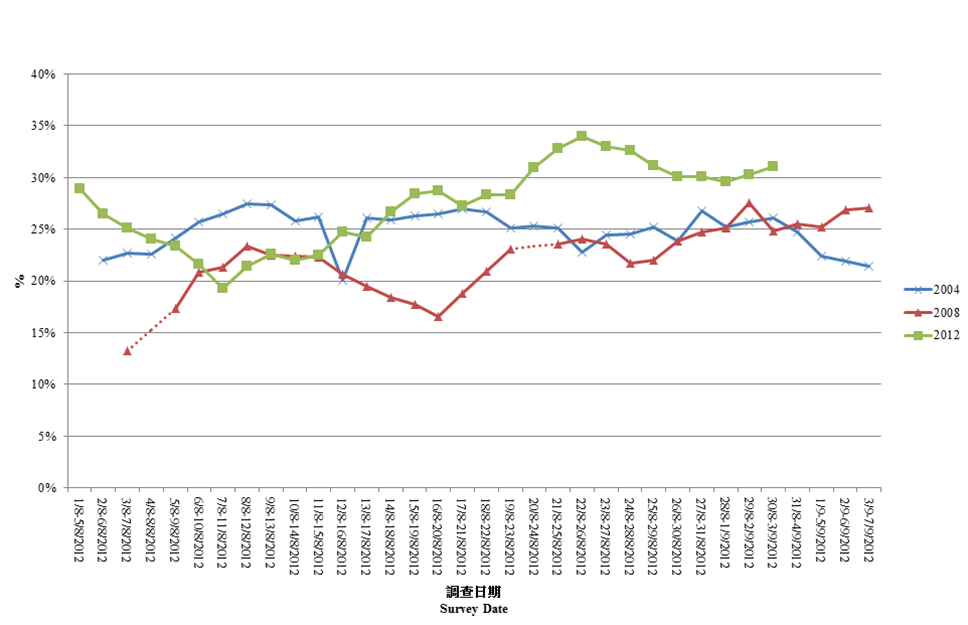HKU POP releases Legislative Council election survey for the third timeBack
| Press Release on September 5, 2012 | ||||||||
|
| Abstract | Latest Figures | Commentary | Future Releases (Tentative) | | ||||||||
Abstract The Public Opinion Programme (POP) at the University of Hong Kong interviewed 13,457 registered voters in between August 1 to September 3, 2012 by means of random telephone surveys separately conducted by real interviewers. As of September 3, our Legislative Council rolling poll shows that after a significant drop in the middle of the campaign period, voters’ propensity to vote is now on the rise, and approaching the 2008 level. Because we are having a one-person-two-votes system this time, if any voter is attracted to any one of the two votes, the voter will vote. That means the turnout will be jacked up due to this structural factor. For this reason, we should be expecting a higher turnout rate than last time. Of course, we will need to wait and see what will happen at the end. POP will not provide any further projection. Regarding stray voters, across the five geographical constituencies at this final stage, other than New Territories East which has more stray voters than before, all other constituencies are showing a similar trend as that of 2008. As for the so-called “Super DC” election, figures show that voters’ knowledge of the system has been increasing steadily, to a fairly acceptable level now. This also explains to some extent voters’ increasing propensity to vote. The maximum sampling error of all percentages is +/-3 percentage points at 95% confidence level. The effective response rate of the rolling survey is 69%. Points to note: [1] The address of the "HKU POP SITE" is http://hkupop.pori.hk, journalists can check out the details of the survey there. [4] When quoting percentages of this survey, journalists should refrain from reporting decimal places in order to match the precision level of the figures.
| ||||||||
Latest Figures Whenever there are large-scale elections, POP would conduct regular surveys to track opinion changes. On election days, POP would also conduct exit polls to study voter behaviour and motivation. Sponsored surveys will be used exclusively by sponsors first, and then uploaded online for public consumption after the election. Unsponsored surveys will be released to the general public immediately after they are conducted. On August 14 and 23, POP made the first and second public releases respectively, today is the third one, with the following contact information. All figures have been weighted according to the distribution of age, gender and geographic constituency of registered voters in the 2012 electoral roll provided by the Registration and Electoral Office:
Three findings of this rolling survey are summarized below, together with parallel figures obtained in the last Legislative Council elections of 2004 and 2008 for the first two findings:
1. Propensity to vote
[7] The “survey date” shown in the above table only applies to 2012. Findings from the 2004 and 2008 surveys are syncrhonized using the election count-down date.
Survey revealed that the propensity to vote in general falls within the range of 81% to 88%. It started with 84%, then rose to 88% in mid-August, followed by dropping to as low as 81% in late-August and finally rebounded to 83% recently. If to compare with 2004 and 2008, the fluctuations seems to be more significant this year.
2. Percentage of stray voters
Since many voters still had not decided how to cast their vote, while stray voters would always have significant influence on the election result, the POP Team therefore further look into the distribution of these votes in 5 constituencies. In this analysis, “stray voters” are defined as respondents who said they would definitely or very likely vote, but have not disclosed how they would vote.
Hong Kong Island [8] The “survey date” shown in the above table only applies to 2012. Findings from the 2004 and 2008 surveys are syncrhonized using the election count-down date.
Kowloon West [9] The “survey date” shown in the above table only applies to 2012. Findings from the 2004 and 2008 surveys are syncrhonized using the election count-down date.
Kowloon East [10] The “survey date” shown in the above table only applies to 2012. Findings from the 2004 and 2008 surveys are syncrhonized using the election count-down date. New Territories West [11] The “survey date” shown in the above table only applies to 2012. Findings from the 2004 and 2008 surveys are syncrhonized using the election count-down date.
New Territories East [12] The “survey date” shown in the above table only applies to 2012. Findings from the 2004 and 2008 surveys are syncrhonized using the election count-down date. District Council (Second) Functional Constituency Similar to what happened in 2004 and 2008, the percentage of stray voters in this year fall within 20% to 30% up to now in various districts, except for New Territories East where the percentage was as high as 35% for once. 3. Awareness of being Super DC voters
With respect to the new District Council (Second) Functional Constituency (also known as Super DC) election, our rolling surveys show that 60% of the voters were well understood that he or she is a registered voter of “Super DC election”. The percentage has risen significantly from 34% (early August) to 60% (late August to early September). On the other hand, those who remained uncertain have dropped significantly from 56% to 31%. Meanwhile, 10% of the respondents of those self-proclaimed non-voters remained unchanged.
| ||||||||
Commentary Note: The following commentary was written by Director of POP Robert Chung.
| ||||||||
Future Releases (Tentative)
| ||||||||
|
| Abstract | Latest Figures | Commentary | Future Releases (Tentative) | |















